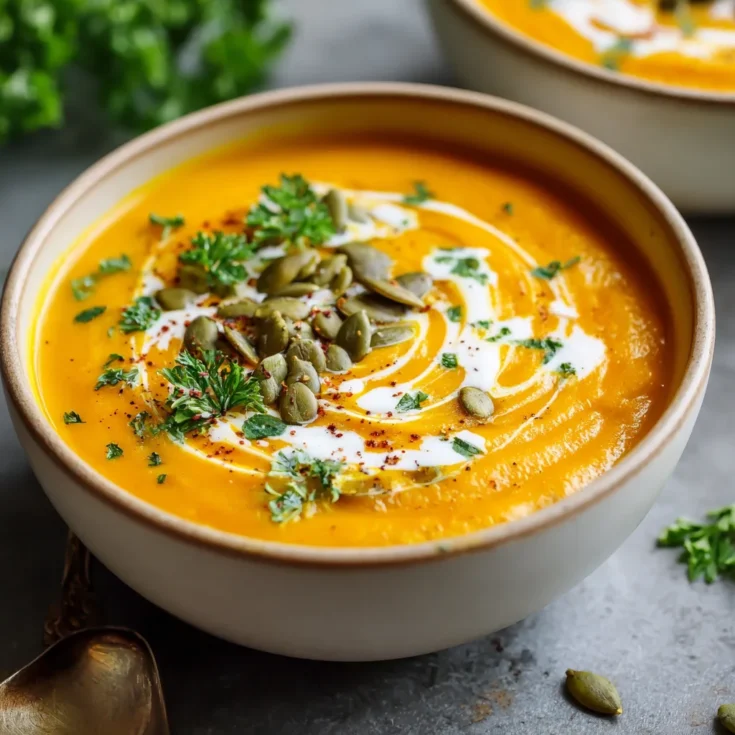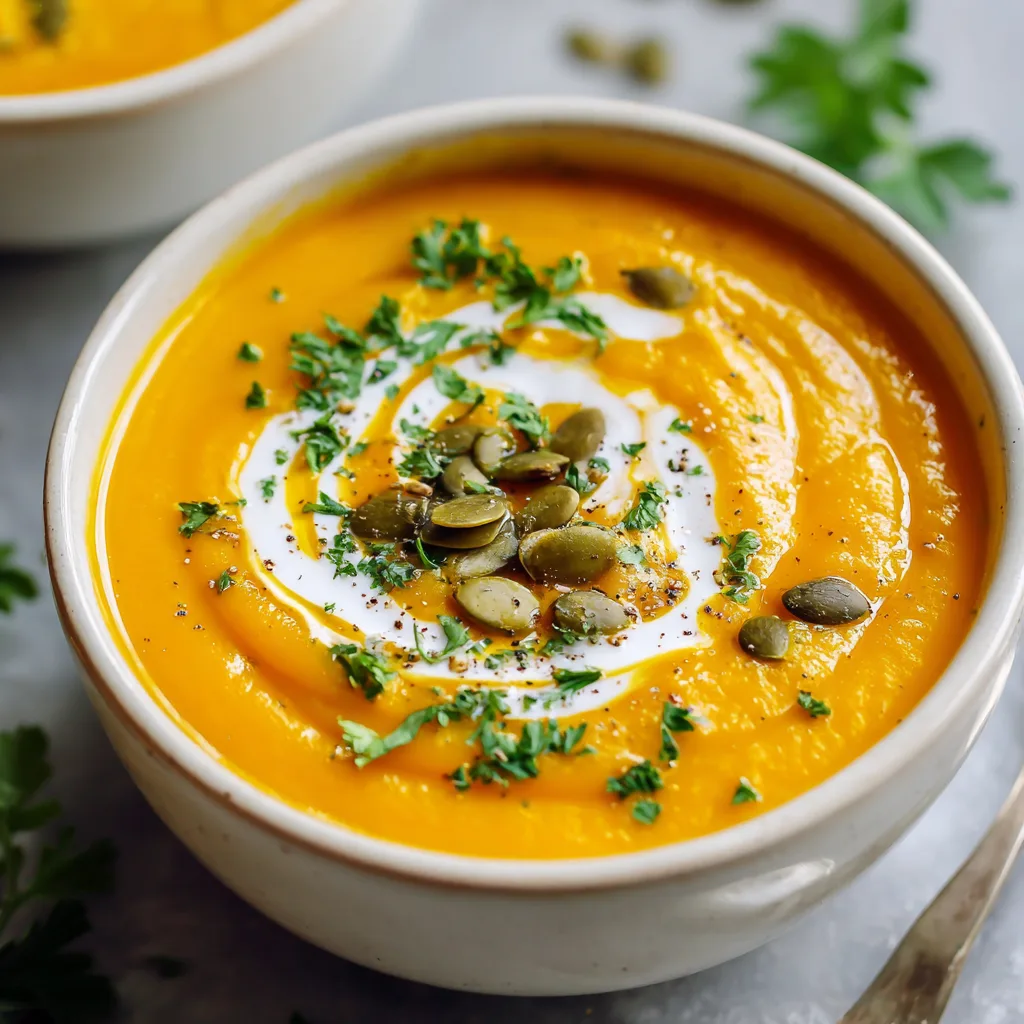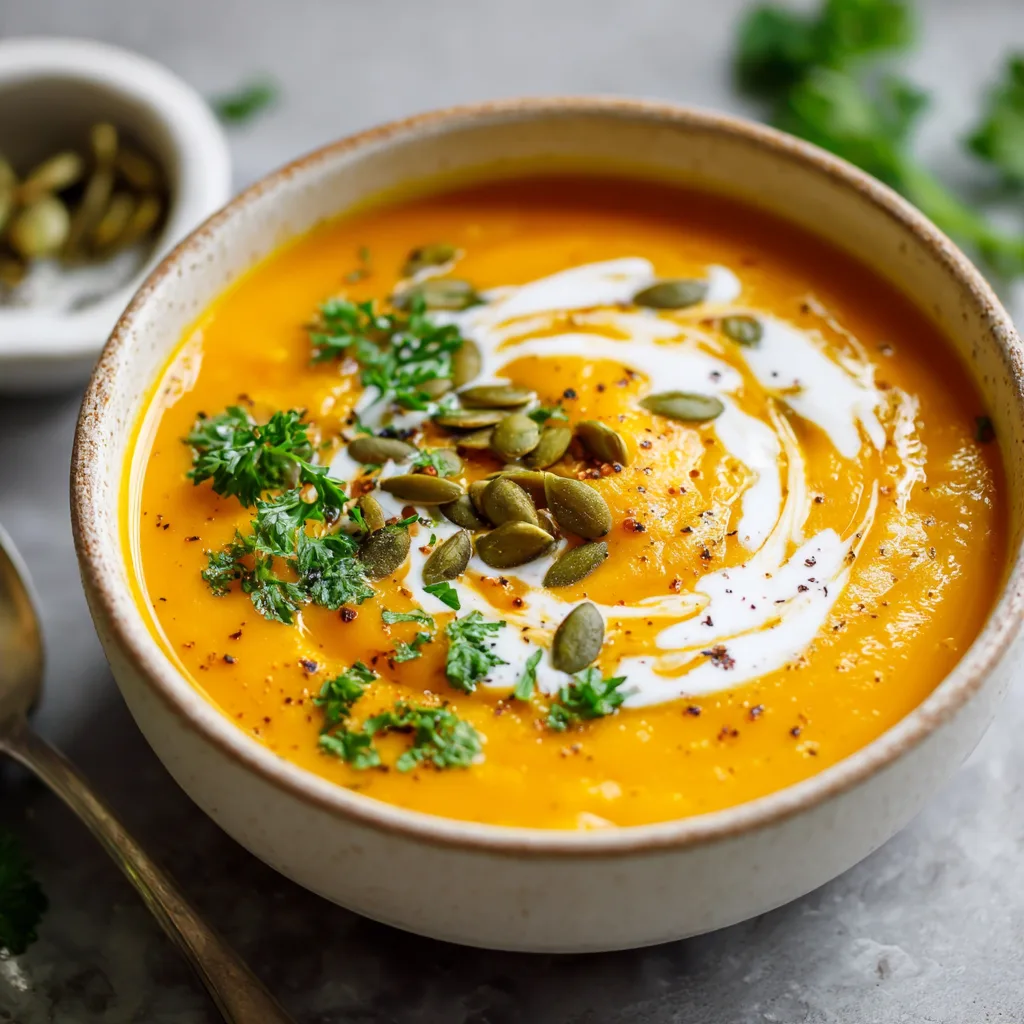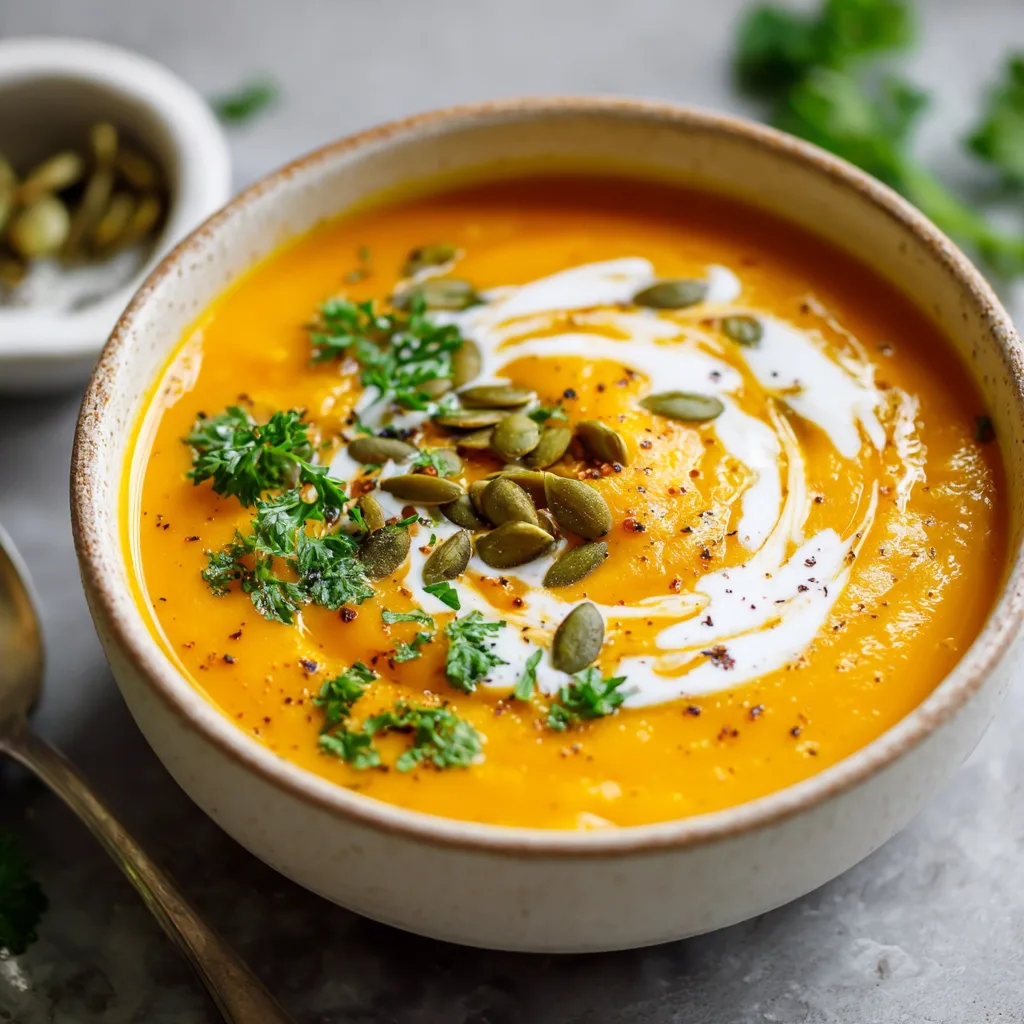Introduction to One-Pot Low Carb Pumpkin Soup
Embracing Seasonal Flavors with a Healthy Twist
Pumpkin is a beloved seasonal ingredient that signals the arrival of cooler months and cozy meals. Its natural sweetness and creamy texture make it a perfect base for soups, stews, and purees. Beyond taste, pumpkin packs a nutritional punch, rich in vitamins and fiber. Many people are embracing pumpkin not just for flavor but also for its health benefits. At the same time, low-carb diets have surged in popularity, as they promote weight management and support balanced blood sugar levels. Combining the seasonal charm of pumpkin with the health-conscious low-carb approach creates a delicious and nourishing dish that fits today’s wellness trends.
The Convenience of One-Pot Cooking
One-pot meals have become essential for busy lifestyles. They simplify cooking by minimizing prep time and reducing cleanup, allowing you to spend less time in the kitchen and more time enjoying your food. This convenience makes one-pot dishes perfect for quick weeknight dinners or meal prepping. A one-pot low carb pumpkin soup is an ideal example, blending wholesome ingredients into a flavorful meal with minimal effort. It offers the best of both worlds: a comforting, healthy dish that fits a low-carb lifestyle and a time-saving approach that suits any schedule. Whether you’re cooking for yourself or your family, this soup delivers nutrition and ease in every spoonful.
Nutritional Profile of Pumpkin Soup
Low-Carb Content: Why Pumpkin Fits Low-Carb Diets
Pumpkin naturally contains fewer carbohydrates than many starchy vegetables, making it an excellent choice for low-carb eating plans. A typical cup of pumpkin puree holds about 7 grams of carbs, with 1.5 grams coming from fiber, which lowers the net carb count to roughly 5.5 grams. This makes pumpkin suitable for keto and other low-carb diets, especially when paired with other low-carb ingredients. Some pumpkin soup recipes vary in carb content depending on added ingredients like cream or sweeteners. For example, a basic one-pot pumpkin soup can have as low as 4 grams of net carbs per serving, while richer versions with added root vegetables or thickeners might increase the carb count to 8-10 grams. Choosing the right recipe keeps your meal aligned with your dietary goals.
Rich in Nutrients: Vitamins and Minerals in Pumpkin
Pumpkin is packed with essential vitamins and minerals that support overall health. It provides an abundance of vitamin A, mostly in the form of beta-carotene, which promotes good vision and immune function. Vitamin C in pumpkin boosts immunity and skin health, while potassium helps regulate blood pressure and fluid balance. These nutrients contribute to overall vitality and wellness. Consuming pumpkin soup allows you to enjoy these benefits in a comforting, easy-to-digest form, making it a nutritious addition to any meal plan.
High in Fiber: Supporting Digestion and Blood Sugar Control
Fiber plays a vital role in maintaining digestive health and stabilizing blood sugar levels. Pumpkin contains both soluble and insoluble fiber, which helps slow digestion and prevents rapid spikes in blood sugar. This makes pumpkin soup a smart choice for those managing diabetes or aiming for steady energy throughout the day. A typical serving of pumpkin soup delivers around 2 to 3 grams of fiber, contributing to daily fiber needs and promoting fullness. Including fiber-rich foods like pumpkin soup supports gut health and long-term wellness.
Protein and Fat Content: Enhancing Satiety and Nutrition
While pumpkin itself contains minimal protein and fat, many low-carb pumpkin soup recipes incorporate ingredients that boost these macronutrients. Adding heavy cream, coconut milk, or cheese increases healthy fat content, helping you stay satisfied longer. Incorporating protein sources like chicken, sausage, or plant-based alternatives balances the meal and supports muscle maintenance. This combination of protein and fat in pumpkin soup enhances satiety, reduces cravings, and contributes to balanced blood sugar levels. Tailoring the recipe to your dietary needs ensures a nourishing and fulfilling dish.
Exploring Different Flavors in Pumpkin Soup
Classic Creamy Pumpkin Soup: A Timeless Favorite
The classic creamy pumpkin soup combines smooth pumpkin puree with savory chicken broth, a splash of heavy cream, and simple seasonings like salt, pepper, and nutmeg. This recipe offers a velvety texture and a rich, comforting flavor that highlights the natural sweetness of pumpkin. The cream softens the pumpkin’s earthiness, while the broth adds depth. This traditional version suits those who crave a straightforward, warming meal with familiar flavors. Its simplicity also makes it a great base for customizing with herbs or spices, allowing cooks to tailor it to their taste preferences.
Spicy Pumpkin Soup: Adding Bold Heat and Warmth
For those who enjoy a kick, spicy pumpkin soup introduces bold spices such as curry powder, cumin, chili flakes, or smoked paprika. These ingredients awaken the palate by adding layers of warmth and complexity. Curry powder, for example, brings aromatic earthiness, while chili flakes add a subtle heat that contrasts beautifully with pumpkin’s sweetness. Spicy pumpkin soup excites the taste buds and adds a vibrant twist to the traditional recipe. It also warms you up on chilly days, making it a favorite among spice lovers.
Coconut Pumpkin Soup: Creamy, Dairy-Free Delight
Using coconut milk in pumpkin soup creates a luscious, tropical flavor with a creamy texture. This variation appeals especially to those seeking dairy-free or vegan options. Coconut milk lends a subtle sweetness and richness that complements the pumpkin perfectly. Additionally, the healthy fats in coconut milk provide satiety and enhance the soup’s smooth mouthfeel. This dairy-free version maintains the comforting qualities of classic pumpkin soup while catering to dietary restrictions or preferences. It often includes fragrant spices like ginger or lemongrass to elevate the tropical profile.
Savory Pumpkin Soup with Sausage: Hearty and Protein-Packed
Adding sausage to pumpkin soup boosts its protein content and introduces savory depth. Ground or sliced sausage, browned before combining with pumpkin and broth, lends a smoky, spicy flavor that contrasts the pumpkin’s sweetness. This variation creates a hearty, satisfying dish perfect for colder months or when you need a filling meal. The richness of sausage balances the lightness of pumpkin, resulting in a well-rounded soup that appeals to meat lovers. This version often includes herbs like thyme or sage to complement the flavors.
Vegetarian and Vegan Pumpkin Soup Options: Plant-Based and Nourishing
Vegetarian and vegan pumpkin soups swap chicken broth for vegetable broth and replace dairy cream with plant-based alternatives like coconut milk, cashew cream, or oat milk. These swaps keep the soup creamy and flavorful without animal products. Nutritionally, plant-based options may have less saturated fat but still provide fiber, vitamins, and minerals from pumpkin and vegetables. Adding legumes or tofu can enhance protein content. This approach caters to those following plant-based diets while ensuring the soup remains rich, comforting, and nutritious.
International Flavors: Global Inspirations for Pumpkin Soup
Pumpkin soup adapts well to international flavors, introducing exciting twists from around the world. Thai-inspired versions often include lemongrass, ginger, and lime, creating a bright, fragrant soup with a hint of spice. Indian-style pumpkin soups use garam masala, turmeric, and cumin, offering warm, earthy notes and vibrant color. These global variations diversify pumpkin soup’s taste and make it a versatile dish that fits various culinary preferences. Exploring international spices enriches the pumpkin soup experience, making it both familiar and adventurous.
Mastering the Art of One-Pot Cooking
Selecting the Right Pot for One-Pot Meals
Choosing the right pot plays a crucial role in perfecting one-pot cooking. Heavy-bottomed pots like Dutch ovens or large saucepans ensure even heat distribution, preventing hotspots that can burn ingredients. These pots retain heat well, allowing your soup to simmer gently and cook evenly. A pot with a tight-fitting lid helps trap moisture and flavor, enhancing the overall taste. Investing in quality cookware can make your cooking process smoother and results more consistent.
Sautéing Aromatics: Building a Flavorful Base
Sautéing onions, garlic, and spices at the start creates a rich flavor foundation for your pumpkin soup. Begin by heating a bit of oil or butter over medium heat. Add diced onions and cook until translucent, stirring frequently to prevent burning. Next, add minced garlic and spices like cumin or cinnamon, cooking just until fragrant—about 30 seconds to 1 minute. Avoid high heat, as it can scorch delicate aromatics and create bitterness. Patience here pays off by enhancing the soup’s complexity.
Simmering for Flavor Development
Simmering allows the soup’s flavors to meld and deepen. Once all ingredients combine, bring the mixture to a gentle simmer rather than a rapid boil. This slow cooking preserves texture and prevents separation. Depending on the recipe, simmer times can vary. For pureed pumpkin soup, 15 to 20 minutes usually suffices to soften ingredients and marry flavors. For soups with added proteins or vegetables, slightly longer simmering may be needed to fully cook those components. Keep the heat low and stir occasionally.
Blending Techniques for Smooth Texture
Blending transforms your soup into a silky, creamy delight. Immersion blenders offer convenience by allowing you to blend directly in the pot, minimizing cleanup. They provide good control over texture, letting you pulse until you reach your preferred consistency. Alternatively, traditional countertop blenders can yield ultra-smooth results but require transferring hot soup carefully in batches. Whichever tool you choose, blend cautiously to avoid splatters and burns. If you prefer a chunkier texture, pulse less or blend only part of the soup.
Adjusting Seasonings: Balancing Flavor
Tasting and adjusting seasonings throughout cooking is essential. Start by seasoning lightly and build gradually. Salt enhances all flavors, but too much can overpower. If the soup tastes flat, add a splash of acid such as lemon juice or vinegar to brighten it. For sweetness, a small pinch of sugar or a drizzle of honey can balance acidity or spice. Remember, seasoning is personal; taste often and adjust accordingly until your pumpkin soup reaches perfect harmony.
Enhancing the Dining Experience
Garnishing Your Soup for Added Flavor and Texture
Garnishes elevate your one-pot low carb pumpkin soup by adding bursts of flavor, texture, and visual appeal. Fresh herbs like parsley, chives, or cilantro introduce a bright, herbal note that contrasts the soup’s creamy richness. A dollop of sour cream or Greek yogurt adds tanginess and extra creaminess, enhancing mouthfeel. Roasted pumpkin seeds or toasted nuts provide satisfying crunch and a nutty flavor that complements the smooth soup. These simple toppings transform a humble bowl into a more engaging and enjoyable meal.
Pairing with Low-Carb Sides for Balanced Meals
Complement your pumpkin soup with thoughtfully chosen low-carb side dishes to create a well-rounded meal. Crisp green salads dressed with lemon vinaigrette add freshness and lightness. Low-carb breads, such as almond flour biscuits or flaxseed crackers, offer texture and substance without excess carbohydrates. Roasted vegetables like Brussels sprouts, cauliflower, or asparagus introduce variety in flavor and nutrients. These sides harmonize with the soup’s flavors while keeping your meal within low-carb guidelines, ensuring satisfaction and balance.
Meal Planning Tips for Weekly Success
Integrating one-pot low carb pumpkin soup into your weekly meal plan offers convenience and nutrition. Prepare larger batches and store leftovers in airtight containers for up to three days in the refrigerator. The soup also freezes well, allowing you to portion it for future meals. When reheating, add a splash of broth or cream to restore creaminess. Consider serving the soup as a main dish with protein-rich sides or as a starter paired with salads. Adjust portion sizes based on appetite and dietary goals. Planning ahead with pumpkin soup simplifies healthy eating on busy days while keeping your menu exciting.
Common Inquiries About One-Pot Low Carb Pumpkin Soup
Is pumpkin soup suitable for a keto diet?
Yes, pumpkin is low in carbohydrates and high in fiber, making it suitable for keto diets.
Can I use fresh pumpkin instead of canned?
Absolutely, fresh pumpkin can be roasted and pureed for use in the soup.
How can I make the soup spicier?
Add spices like cayenne pepper, chili flakes, or a dash of hot sauce to increase heat.
Can I freeze the soup?
Yes, the soup can be frozen without the cream. Add cream after reheating.
What are some low-carb toppings for the soup?
Consider toppings like shredded cheese, bacon bits, or a dollop of sour cream.
How can I make the soup vegan?
Use vegetable broth and substitute heavy cream with coconut milk or a plant-based cream.
Can I add other vegetables to the soup?
Yes, vegetables like spinach, kale, or cauliflower can be added for extra nutrition.
One-Pot Low Carb Pumpkin Soup – Creamy, Healthy, and Easy Fall Recipe

A creamy and comforting pumpkin soup made with minimal ingredients, perfect for a quick and healthy meal.
Ingredients
- 1 can (15 oz) pumpkin puree
- 4 cups chicken broth
- 1/2 cup heavy cream
- 1 small onion, diced
- 2 cloves garlic, minced
- 1 tsp ground cumin
- 1/2 tsp ground cinnamon
- Salt and pepper to taste
- Optional: sour cream, roasted pumpkin seeds, fresh parsley for garnish
Instructions
Notes




